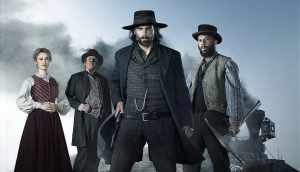
by Bryan Caswell and Heather Clancy
In the summer of 2016, one of my personal institutions came to a close. AMC’s gritty, historically-grounded series Hell on Wheels wrapped up its final season and sailed off into the sunset. Hell on Wheels is one of my all-time favorites, and with the intent of reviewing it on Concerning History (and introducing Heather to it), we have recently been watching the entire series. In order to give due justice to this loaded show, Heather and I will be breaking it down into three separate reviews. What follows is the first, covering its inaugural two seasons.
It is often bemoaned among historians of the American Civil War that the war’s western action is criminally under-studied (though these days that really only still applies to action west of the Mississippi). An equally underappreciated topic is the era immediately after the war, as veterans struggled to readjust to civilian life after ‘seeing the elephant.’ Put these two together in one TV show and you get Hell on Wheels. This gritty western follows Cullen Bohannon, an ex-Confederate, as he gets swept up in the construction of the transcontinental railroad in the late 1860s and holds a wealth of historical landmarks and themes that will leave a discerning historical audience excited (and, in some cases, highly annoyed).

In the first two seasons of Hell on Wheels, the scars of the Civil War are on full display, and while they continue to be evident in later seasons, it is here that we see the (successful and unsuccessful) efforts of so many characters to move on from the past. Bohannon (Anson Mount) arrives at Hell on Wheels, the moving tent city that houses the Union Pacific Railroad’s workers, chasing the Union soldiers who murdered his family during the war. The railroad’s chief of police, known as The Swede, bears his own lingering trauma from Andersonville, and Elam Ferguson (Common), the ex-slave leader of the freedmen working crew, struggles to prove himself as a man and equal to Cullen. Season 2 sees ex- Confederate bandits enjoy a (brief) reign of terror, and even Hell on Wheels’ preacher cannot escape his bloody past riding with John Brown in Kansas.
A number of other tantalizing themes weave their way into the show’s tapestry, as well. Joseph Black Moon, a Cheyenne who has converted to Christianity, showcases the dilemma of Native Americans trying to survive an advancing frontier, while Eva, a prostitute captured as a child by the Yavapai, shows the opposite perspective. Even the show’s some-time villain, Thomas ‘Doc’ Durant, plays a compelling proto-robber baron, and his speech closing the pilot episode is wonderfully bombastic.
All these themes aside, however, Hell on Wheels does fall victim to a number of small inaccuracies that can range from annoying to aggravating for the historically-minded. The material culture and costuming, especially for women, ranges from acceptable to downright laughable (why do shows always have prostitutes wearing only a corset! Not a thing!). The Swede’s account of cannibalism at Andersonville is both not historically verifiable and a worrying portent of a sensationalized portrayal of that prison camp (on which more in a future season’s review). Perhaps the most factually problematic is Bohannon’s military backstory. The first we learn of his service is when he tells a Union cavalryman he fought to defend Burnside’s Bridge at Sharpsburg (sparking a humorous argument over just what that battle was called and who can consider it a victory), which would place him in a Georgian infantry (sharpshooters) regiment. In the Season 1 finale, however, we see Bohannon ride home wearing a gold-piped cavalryman’s uniform. Also inconsistent is the death of his family; murdered by Union soldiers on “Sherman’s march south,” Bohannon’s family actually lived in Meridian, Mississippi, nowhere near any possible interpretation of what action that phrase describes.

While the above are mostly minute details, there is one larger theme that I quibble with in the opening seasons of Hell on Wheels. The decision to make our main character a Confederate, avenging a Union atrocity no less, lies a bit too close to the Lost Cause for my own comfort. As these seasons progress, we learn that Bohannon did own slaves, but freed them before the war at his wife’s behest, giving him that mythical chevalier air, fighting for honor rather than slavery. Thankfully, the series makes very clear that the war was fought over slavery (and all the characters acknowledge that fact), so the Lost Cause proper is kept at bay. Still, I could do without all the underdog, outnumbered-yet-bravely-soldiered-on rhetoric.
In the end, the first two seasons of Hell on Wheels provide a wild ride in the immediate post-Civil War era. Filled with tantalizing references to the conflict so recently concluded, these seasons demonstrate most explicitly how, as the title cards explain, the intercontinental railroad will bind up the battered nation’s wounds. As all its various characters get swept up in the Herculean effort, they all continue fighting their own wars, as well.

One reply on “Each Man’s Own War: Hell on Wheels, Seasons 1 & 2”
I remember enjoying the first two seasons of this show some years back, and fell out of it for whatever reason.
I’ve been thinking lately of revisiting the series and wondered how well it handled the cause of the Civil War, if it leaned at all into Lost Cause mythology. This is the exact sort of review I needed! Thank you!